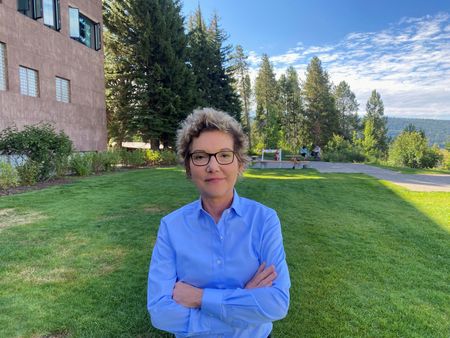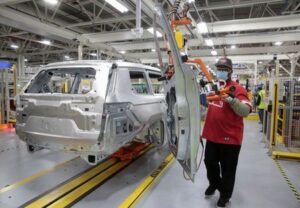By Ann Saphir
(Reuters) – The Federal Reserve needs to cut interest rates to keep the labor market healthy, but it is now down to incoming economic data to determine by how much, San Francisco Fed President Mary Daly said on Wednesday.
“As inflation falls, we’ve got a real rate of interest that’s rising into a slowing economy; that’s a basic recipe for over-tightening,” Daly told Reuters in an interview.
Labor market health, she said, has to be “sustained and protected, and we have to be very mindful that if policy is overly tight, you might get additional slowing in the labor market, and to my mind, that would be unwelcome.”
So far, though, the labor market has softened but is still healthy, she said.
Daly and her colleagues are widely expected to cut interest rates at their upcoming policy meeting, on Sept. 17-18. The Fed raised borrowing costs rapidly in 2022 and 2023 and has held the policy rate in the 5.25%-5.50% range for more than a year to bring down inflation.
Most analysts expect the Fed to stick to a quarter-point rate cut at the September meeting, though analysts are keenly awaiting the U.S. Labor Department’s August monthly employment report, due on Friday, for any sign of further job market softening that could trigger a bigger Fed response.
Financial markets earlier on Wednesday added to bets on an upsized half-point rate cut this month after government data showed U.S. job openings in July fell to the lowest level in three and a half years, and the ratio of job openings to job seekers – a metric of labor market tightness — is now below the pre-pandemic average.
To Daly, however, the report showed a labor market that is in balance but not weak.
“It’s hard to really find evidence that it’s even faltering,” she said.
Wages are growing faster than inflation and workers are still finding jobs. And while businesses tell Daly that they are being “frugal” with hiring, they are not “dusting off their layoff manuals,” she said.
The Fed reserves “aggressive” moves for times when the outlook is certain, she said – for instance, the 2020 pandemic shutdowns, which triggered the Fed’s decision to slash rates to near zero.
The current outlook is less certain, Daly said, adding that as she talks to people in the communities she visits, they still name inflation as their number one concern.
“We do not have price stability,” she said. With inflation still running above the Fed’s 2% goal, “we have to continue to assert downward pressure on it.”
As for how big a rate cut is needed, “We don’t know yet, right?” Daly said. “We have a labor market report, we have a CPI report, we have all of our contact information — I’m in the midst of collecting all this information,” adding that she’ll also need to discuss the data with her staff and her policymaking colleagues. “I want more time to do all the work that’s needed to do to make the best decision.”
The Fed needs to keep the labor market about where it is now, with an expectation it will continue to expand, Daly said, “if people are going to regain some of the losses from the high inflation period, and also if we’re going to get to this place and people go look back and say, ‘Okay, we got inflation down, gently, without breaking the economy.’ That’s the goal.”
(Reporting by Ann Saphir; Editing by Leslie Adler)





